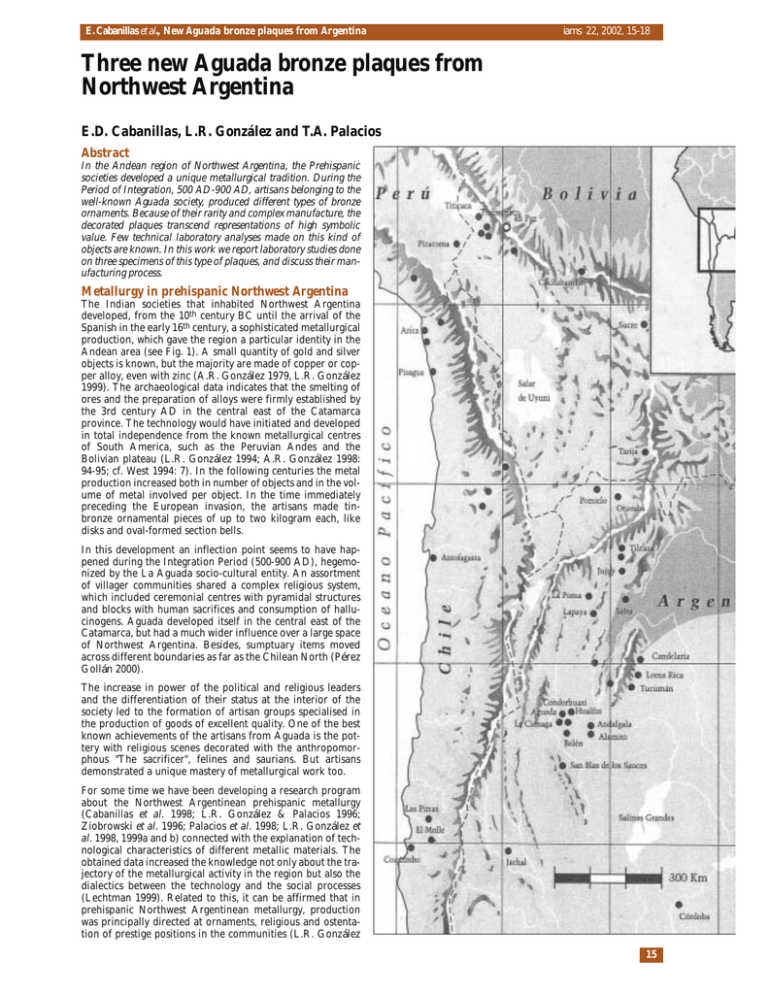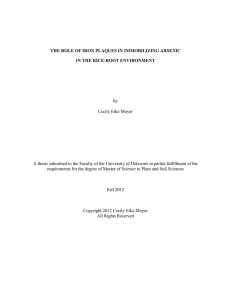Three new Aguada bronze plaques from Northwest Argentina Abstract
advertisement

E. Cabanillas et al., New Aguada bronze plaques from Argentina iams 22, 2002, 15-18 Three new Aguada bronze plaques from Northwest Argentina E.D. Cabanillas, L.R. González and T.A. Palacios Abstract In the Andean region of Northwest Argentina, the Prehispanic societies developed a unique metallurgical tradition. During the Period of Integration, 500 AD-900 AD, artisans belonging to the well-known Aguada society, produced different types of bronze ornaments. Because of their rarity and complex manufacture, the decorated plaques transcend representations of high symbolic value. Few technical laboratory analyses made on this kind of objects are known. In this work we report laboratory studies done on three specimens of this type of plaques, and discuss their manufacturing process. Metallurgy in prehispanic Northwest Argentina The Indian societies that inhabited Northwest Argentina developed, from the 10th century BC until the arrival of the Spanish in the early 16th century, a sophisticated metallurgical production, which gave the region a particular identity in the Andean area (see Fig. 1). A small quantity of gold and silver objects is known, but the majority are made of copper or copper alloy, even with zinc (A.R. González 1979, L.R. González 1999). The archaeological data indicates that the smelting of ores and the preparation of alloys were firmly established by the 3rd century AD in the central east of the Catamarca province. The technology would have initiated and developed in total independence from the known metallurgical centres of South America, such as the Peruvian Andes and the Bolivian plateau (L.R. González 1994; A.R. González 1998: 94-95; cf. West 1994: 7). In the following centuries the metal production increased both in number of objects and in the volume of metal involved per object. In the time immediately preceding the European invasion, the artisans made tinbronze ornamental pieces of up to two kilogram each, like disks and oval-formed section bells. In this development an inflection point seems to have happened during the Integration Period (500-900 AD), hegemonized by the La Aguada socio-cultural entity. An assortment of villager communities shared a complex religious system, which included ceremonial centres with pyramidal structures and blocks with human sacrifices and consumption of hallucinogens. Aguada developed itself in the central east of the Catamarca, but had a much wider influence over a large space of Northwest Argentina. Besides, sumptuary items moved across different boundaries as far as the Chilean North (Pérez Gollán 2000). The increase in power of the political and religious leaders and the differentiation of their status at the interior of the society led to the formation of artisan groups specialised in the production of goods of excellent quality. One of the best known achievements of the artisans from Aguada is the pottery with religious scenes decorated with the anthropomorphous "The sacrificer", felines and saurians. But artisans demonstrated a unique mastery of metallurgical work too. For some time we have been developing a research program about the Northwest Argentinean prehispanic metallurgy (Cabanillas et al. 1998; L.R. González & Palacios 1996; Ziobrowski et al. 1996; Palacios et al. 1998; L.R. González et al. 1998, 1999a and b) connected with the explanation of technological characteristics of different metallic materials. The obtained data increased the knowledge not only about the trajectory of the metallurgical activity in the region but also the dialectics between the technology and the social processes (Lechtman 1999). Related to this, it can be affirmed that in prehispanic Northwest Argentinean metallurgy, production was principally directed at ornaments, religious and ostentation of prestige positions in the communities (L.R. González 15 E. Cabanillas et al., New Aguada bronze plaques from Argentina & Peláez 1999). This situation was particularly noticeable in the context of the Aguada society (A.R. González 1998: 367). The Plaques in the Integration Period The Aguada plaques stand out because of their relative scarcity (only about thirty pieces are known), their detailed decoration and the symbolic charge in their iconography. The majority of these objects do not come from archaeological excavations and this is a problem for scientific studies. Furthermore, many of the pieces are isolated in different, private and public, collections in Europe and America, another reason that impedes the realisation of systematic studies. In these plaques the artisans have introduced two important innovations in metal processing: first the intentional preparation of a copper and tin alloy, and second the sophisticated method of the lost wax casting. They are items of no more than 150 mm diameter. From a formal point of view these plaques were classified according to two variables (A.R. González 1998: 199; A.R. González et al. 2000): shape and decoration. Considering the first aspect, they were grouped as Fig. 2 iams 22, 2002, 15-18 circular, rectangular and exceptional. Regarding the decoration of the plaques, three types were identified: "The personage of the empty hands", "The executioner or sacrificer" and "Two or more individuals". In all situations the central iconographic theme is an anthropomorphous figure in front view with its arms in flexion, a cephalic adornment and dressed up or ornamented with a tunica with echeloned drawings, spirals and rectilinear lines. In "The executioner" case, from its arms hang an axe, knife or representations of cut heads. Together with the central figure sometimes appear zoomorphous beings, such as felines, birds or saurians. The distribution of this type of objects includes different places of Northwest Argentina including Chile and Bolivia. Discussing the different places of occurrence it was proposed that itinerant shamans might have distributed the artefacts as part of the political diffusion of the Aguada religious cult (A.R. González 1998: 100), but the centre of manufacturing is likely to have been Northwest Argentina (A.R. González 1992: 196). Precedent studies The number of technical studies of plaques of similar characteristics is very small. To our knowledge there are three publications on this theme: the first exhaustive work was published by Biloni et al. (1990). The study showed that the plaque investigated was made of bronze, with 2.5 weight % tin and less than 0.3 % arsenic. It was manufactured using the lost wax method (cf. Easby 1966: 74-76), polished and engraved. Lechtman (1991: 78) informed about the composition of another circular plaque cast in the lost wax mode. Its analysis gave 97 % copper, 1.31 % tin and minor quantities of iron, zinc, nickel, silver and lead. The last study was made by Scott (1998: 101-102) on a rectangular piece, again lost wax manufactured, whose chemical analysis gave: copper 88 %, arsenic 0.8 %, tin 8 %, antimony 2.7 %, and some traces of iron. Studies on three Aguada plaques The plaques which this work is concerned with were investigated using dimensional measurements, binocular stereoscopic observations, scanning electron microscopy and quantitative energy dispersive X-ray analysis. The compositional results were obtained as the average of a number of individual measurements. Not considered for the chemical composition were Na, Si, S, Cl, and Ca because they were assumed to be constituents of the patina of the plaques. Plaque No 1 (Circular executioner)This piece, called the Bercheni plaque, was found in the Province of Salta (A.R. González et al. 2000). This disk is surrounded by a concentric band connected by five bridges with two appendices in the upper side (see Fig. 2). On the anterior face is an anthropomorphous central representation with a coiffure, fixed arms, and hands with three large fingers. From each arm hangs one instrument, in one case an axe and in the other a blade cutter. The legs end with three-toed feet. The surrounding band includes two saurian-formed animals, one of them without its upper jaw. The upper appendices end in ornithomorphous heads, with their eyes marked as a depression on the plaque. The back of the plaque is smooth, except behind the heads of the birds, where the anterior face follows their form. 16 E. Cabanillas et al., New Aguada bronze plaques from Argentina The dimension of the plaque is 118.1 mm x 90 mm, with a weight of 115 g. Visual inspection determined the existence of white particles on the surface of the plaque with a tendency to concentrate in the grooves formed by the decorative design. Based on analogy to other objects from the same archaeological region it is assumed that the white substance was calcium phosphate, possibly a residue from the crucible or mould (cf. L.R. González 1997; L.R. González et al. 1999a). There are only minor fabrication defects. The mentioned absence of the jaw of one of the sauries is due to an imperfection in the mould during the pouring of the melted alloy. The border of the animal’s ear is rounded, suggesting a loss of fluidity of the alloy due to cooling. These details indicate that the entrance of the alloy into the mould occurred at the side opposite from the appendices with the birds figures. The composition was found to be 85.4 % copper and 14.6 % tin. The metallographic study revealed an as-cast solidification microstructure with a copper-tin eutectic in the interdendritic spaces and some globular oxides. iams 22, 2002, 15-18 Fig. 3 Plaque No 2 (Rectangular executioner) The origin of this rectangular plaque is not known. On its anterior face there is an anthropomorphous figure whose head surpasses from the upper edge. The figure is represented in front view, with its two arms flexed. Again, from its left arm hangs a knife and from the other an axe (Fig. 3). The feet are shown in side view. The head of the figure seems to be covered with a zoomorphous mask with a snout that stands out from the plaque plane. From the snout hangs a large moustache lying on the front of the plaque. In addition, the ears have circular depressions which probably held some ornamental stones. The posterior face is smooth with a small depression that communicates to the snout. The dimensions are 94.1 mm in height and a weight of 135 g. The microscopic observations allowed us to identify a roughness of the surface, which we attribute to the used mould, the grinding substances and remains of a white powder which is supposed to have been used as a coating. The composition of the plaque is 96 % copper and 4 % tin. A complex substance on the surface was identified as paracatamite [Cu2(OH)3Cl], a well know corrosion product of copper and its alloys. Metallographic observation showed rounded grain boundaries with equiaxial tendency. The size of the grains suggested a low cooling process of the metal. Groups of slip lines indicate that the plaque undergone a light mechanical work. Plaque No 3 (Rectangular executioner) The plaque studied is of unknown origin and minor fabrication quality. The head is an anthropomorphic figure surpassing from the upper rim (see Fig. 4). The face of the person presents its eyes profoundly marked, the cavities may have sheltered ornamental or precious stones. A semicircular headgear surrounds the head. At both sides of the neck are easily seen holes that have been done by cold working. On the upper edge of the headgear, a cut indicates the position of the inlet of the mould. Discussion and conclusions The information obtained from the reported studies allows us to recognize similarities and particularities in the characteristics of each plaque. The three pieces were made with the lost wax process and in each case the principal entrance for the liquid metal was on the upper part of the plaque. The use of the lost wax method is confirmed by the observed metallographic structures and is also indicated by the qualities of the surfaces. The very complex forms of the spectacular details of the heads and other details of very small dimensions can only have been done using this method. After being extracted from the mould the pieces were subjected to some minor finishing operations. At least in Plaques No 1 and 2, the mould face appears to have been covered by a dusting or emulsion of calcium phosphate. In Plaque No 3 no evidence was found of this type of covering, Fig. 4 The figure has flexed arms and from the right one hangs an axe. The leg lines disappear to the lower part and the feet appear only scarcely. The plaque weighs 53.5 g, is 81 mm in length, 51 mm in height, and has an average thickness of 1.7 mm. The thickness is less in the lower part of the plaque to the left, where a fracture is observed in an area of surface roughness. The lower left corner has a rounded edge. The chemical analysis indicates that this plaque is 93.5 % copper, 5.8 % tin and minor amounts of iron from the patina. The metallographic studies revealed a dendritic structure of copper and copper oxides, which tends to align along the mentioned fracture line. The plaque was made by the lost wax process, with the inlet from the mould lying on the central upper part of the plaque. A casting defect happened, resulting in an incomplete filling of the lower part of the mould. 17 E. Cabanillas et al., New Aguada bronze plaques from Argentina but perhaps such evidence was removed by a different cleaning done by successive owners. The mentioned emulsion is white and could have been obtained from burnt and milled bones used as the very first fine cover of the wax model. This white substance is commonly found in all the metallurgical products of Northwest Argentina during the subsequent periods. All the plaques show some fabrication defects always connected with an incomplete filling of the mould. Taking into account the tin quantities in the studied plaques and three others studied by different researches, we are able to confirm that the Aguada artisans worked in an authentic bronze. The concentrations of tin are different in the different plaques, but the incorporation of tin was deliberately done; in Northwest Argentina there are no associated minerals with both copper and tin and the registered compositions are too high to be explained by contamination. The alloy resulted from a technological choice, including the provision of different metals found in separate geographical areas. It also demonstrates an increase of the transformation operations and the capability put on them by artisans and other workers. In the Andes the interest to develop bronzes was an indication of the acceleration and demonstration of differential status and religious messages (Lechtman 1984: 45, 1988: 369). The use of tin means a change in the colour of metal, from red to golden. The golden colour remits to heliocentric cults that were fully developed in relation with the Aguada plaques (Pérez Gollán, 1986; A.R. González 1992; A.R. González et al. 2000). Moreover, the addition of tin lowers the melting temperature of copper and above all improves the filling conditions (Coghlan 1975; Craddock 1995; Tylecote 1979, 1987). Altogether, very sophisticated considerations must have been taken into account in order to design and manufacture these difficult pieces. The dissimilar content of tin in the composition of the plaques could have been a result of hazardous circumstances of their making. The considerably high percentage of tin observed in Plaque No 1 suggests an intentional measure of the alloying. One may hypothesise about the availability of tin ores. In Northwest Argentina, tin minerals are rare compared with copper ones, and the artisans of different geographical zones could have economised the use of tin, using the minimum quantities necessary in order to reach the intended valued conditions. Considering this point of view Plaque No 1 may have been made by people with a significantly higher availability of tin, from ores or merchandising. The three studied plaques have cavities that may have been designed for precious or ornamental stones, as suggested by A.R. González (1992: 250). This ornamentation has not been found on the plaques. We suspect that this practise must have been more usual than commonly thought, and that the rare mention of ornamentation with known registered metal objects is due to the degradation of the natural adhesives used, and the subsequent loss of the inlays (L.R. González et al. 2001). The laboratory studies emphasise the idea of the high symbolic value that these plaques may have had, considering the investment of labour, the technical knowledge involved, and the related degree of production organisation. Not only the paramount qualities of artist and artisans are detectable, but also the control over many physical and chemical properties connected with the material science applied during the manufacture of these objects. The used ores may have been obtained from different mineral sources, which means a well-established knowledge of the regional geology and an efficient logistic organisation with its social and political legitimisation. The connected complexity inherent to the productive process suggests the involvement of specialised artisans who developed their task in an institutionally formalized frame. It seems clear that the technological style and the innovations that developed in the Aguada metallurgy did not respond to practical necessities, but to the development of dominant ideologies. 18 iams 22, 2002, 15-18 Acknowledgements We are indebted to the Comisión Nacional de Energía Atómica, Department of Materials and to Ricardo Montero for his valuable help in the metallographical task. The authors also wish to thank the referees of the original paper for their effort. References Biloni, H., Kiss, F., Palacios, T. & Vasallo, D. 1990. Análisis metalográfico de la placa de Lafone Quevedo. Serie Difusión, 7, CIC (Comisión de investigaciones científicas de la Provincia de Buenos Aires, Argentina). Cabanillas, E.D., Losinno, B.N., Palacios, T. & Gonzalez, L.R. 1998. Estudio composicional de piezas de Ambato. In: Anales Jornadas de la Sociedad Argentina de Metales ‘98, IBEROMET V, II, 639-642. Rosario, Argentina. Coghlan, H.H. 1975. Notes on prehistoric metallurgy of copper and bronze in the Old World. Occasional Papers on Technology 4. Pitt Rivers Museum, University of Oxford, Oxford. Craddock, P. 1995. Early metal mining and production. Edinburgh University Press, Edinburgh. Easby, D. 1966. Early metallurgy in the New World. Scientific American 214, 4, 73-81. New York. Gonzalez, A.R. 1979. Precolumbian metallurgy of Northwest Argentina. Historical development and cultural process. In: E. Benson (ed) Precolumbian Metallurgy of South America, 133-202. Dumbarton Oaks, Washington. Gonzalez, A.R. 1992. Las placas metálicas de los Andes del Sur. Materialien zur Allgemeinen und Vergleichenden Archaeologie 46, von Zabern, Mainz. Gonzalez, A.R. 1998. Cultura de la Aguada. Arqueología y diseños. Filmediciones Valero, Buenos Aires. Gonzalez, A.R., Perez Gollan J.A. & Llamazares A.M. (in press). Nuevos ejem plares de placas metálicas de los Andes del Sur. Boletín del Museo Chileno de Arte Precolombino, Santiago, Chile. Gonzalez, L.R. 1994. El bronce que sonríe. Metalurgia prehispánica en el Noroeste Argentino. Ciencia Hoy 27, 25-31. Gonzalez, L.R. 1997. Cuerpos ardientes. Interacción surandina y tecnología metalúrgica. Estudios Atacameños 14, 189-210. San Pedro de Atacama. Gonzalez, L.R. 1999. Bronce bajo el sol. Metalurgia prehispánica en el Noroeste Argentino. In: P. Stenberg & A. Muñóz (eds) Masked Histories, 97131. Etnologiska Studier 43, Gothemburg. Gonzalez, L.R. & Palacios, T. 1996. El volar es para los pájaros. Análisis técni co de dos piezas metálicas procedentes del valle de Santa María, provincia de Catamarca. Arqueología 6, 25-46. Instituto de Ciencias Antropológicas, Buenos Aires, Argentina. Gonzalez, L.R., Saravia, F. & Montero, R. 1998. Estudio de pieza arqueológica: disco 19742, NOA. In: Anales Jornadas de la Sociedad Argentina de Metales ‘98 IBEROMET V, II, 631-635. Rosario Argentina. Gonzalez, L.R. & Pelaez, P. 1999. De ricos y famosos. Bienes metálicos en las sociedades prehispánicas tardías del Noroeste Argentino. In: C. Diez Marín (ed) Actas del XII Congreso Nacional de Arqueología Argentina, II, 221-232. La Plata. Gonzalez, L.R., Cabanillas, E.D. & Palacios, T. 1999a. El pozo y el tumi. In: Arqueometalurgia del Noroeste Argentino. Cuadernos del INAyPL 18, 207-222. Buenos Aires. Gonzalez, L.R.; Cabanillas, E.D. & Palacios, T. 1999b. Algo más sobre el cere monialismo de altura en el Collasuyu. Análisis técnico de las estatuillas antropomorfas del Cerro Gallán. In: Actas del XIII Congreso Nacional de Arqueología Argentina, I, 329-345. Córdoba. Gonzalez, L.R.; Cabanillas, E.D. & Palacios, T. (in press). Un paso al más allá. Nuevos análisis de materiales metálicos del Noroeste Argentino. In: Actas del XIV Congreso Nacional de Arqueología Argentina. Córdoba. Lechtman, H. 1988. Precolumbian surface metallurgy. Scientific American 250, 6, 38-45. New York. Lechtman, H. 1991. La metalurgia precolombina: tecnología y valores. Análisis técnicos. In: Los Orfebres Olvidados de América, 9-18 and 71-95. Museo Chileno de Arte Precolombino, Santiago, Chile Lechtman, H. 1999. Afterword. In: M.A. Dobres & C. Hoffman (eds) The Social Dynamics of Technology, 223-232. Smithsonian Institution Press, Washington. Palacios, T., Cabanillas, E.D. & Gonzalez, L.R. 1998. Scanning electron microscopy studies of prehispanic metallurgical objects from Northwest Argentine. In: Proceedings of the 14th International Congress on Electron Microscopy, 287-288. Cancún. Perez Gollan, J.A. 1986. Iconografía religiosa andina en el Noroeste Argentino. Bulletin IFEA XV, 3-4, 61-72. Lima. Perez Gollan, J.A. 1986. El jaguar en llamas. La religión en el antiguo Noroeste Argentino. In: Los pueblos Originarios y la Conquista, 229-256. Ed. Sudamericana, Buenos Aires. Scott, D. 1998. Technical examination of South American metals: some examples from Colombia, Perú and Argentina. Boletín del Museo del Oro 44-45, 78105. Bogotá. Tylecote, R. 1979. A History of Metallurgy. Metals Society, London. Tylecote, R. 1987. The Early History of Metallurgy in Europe. Longman, London. West, R. 1994. Aboriginal metallurgy and metalworking in Spanish America: a brief overview. In: A. Craig & R. West (eds) In Quest of Mineral Wealth. Aboriginal and Colonial Mining and Metallurgy in Spanish America, 5-20. Louisiana State University, Baton Rouge. Ziobrowski, C., Cabanillas, E.D., Palacios, T. & Gonzalez, L.R. 1996. Estudio de aleaciones cobre-arsénico. Boletín del Museo del Oro 41, 131-143. Bogotá.


